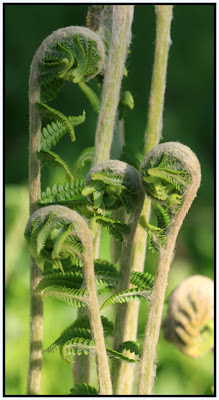Weaving words of grace and gratitude through the fabric of my photography, I wish to share the everyday miracles of God's creation. Writing with a blend of curiosity, discovery, and spirituality, I invite the reader-viewer along a trail of words and images; thoughtfully selected and graciously given.
Wednesday, June 13, 2012
cinnemomea
Ferns are not usually described as gorgeous. They aren't glamorous, or famous in any way.
Their public relations department is understaffed. It must be difficult to promote that whole "alternation of generations" scheme. Compared to the exciting, easy-to-understand methods employed in flower sex.
Ferns have been around for eons. They understand long-term investments. They reproduce by spores rather than seeds.
I will now attempt to reduce the complex, 8-11 step, life cycle of a fern into two sentences:
Gametophytes, the sexual forms that develop from spores, are so inconspicuous in the soil that they are seldom seen. The visible plants that we know as ferns are the asexual Sporophytes, the spore-producing generation that rises from fertilized gametophytes.
Is that clear? No? If you must know, swimming sperms and eggs are involved, and their fusion forms a zygote. That's a fun word.
Truly, it is complicated. If you desire more, you won't find it here, but over here:
A Field Guide to the Ferns (and their Related Families), by Boughton Cobb. My copy is copyrighted 1956 and 1963, but not to worry, ferns still reproduce as they always have.
Oh, there's another simple, understandable method by which ferns reproduce: by budding new stalks from the creeping rootstocks (rhizomes) underground. These can survive for several decades.
Here's a series of Cinnamon Fern photos for you:
This is typical habitat for Cinnamon Ferns, often standing in water. (Click on any photo to enlarge)
A "Fiddlehead" begins to unfurl.
The fuzzy hair you see is often used by birds to line the inner portion of their nests.
A little more open here, with lower leaves expanding.
Here are some of the neighbors in the Fernhood.
Segments of the cinnamon frond show through the ladder of leaves.
Sporophyte stalks ripe and ready for release of spores.
Spores have been spent and sent on their way.
In July, 1978, I earned one summer credit for my Independent Study of Ferns at Grand Valley State University. (GVSU) If you're interested, perhaps you could do the same at a college near you.
So, with a discerning eye, Cinnamon Ferns have their own kind of beauty. As you can see here, they come with their own vase.
Cinnamon Fern (Osmunda cinnemomea)
References:
The Book of Swamp and Bog - John Eastman (Swamp & Bog)
Peterson Field Guide to Ferns - Boughton Cobb (Cobb)
Photo Locations:
Chief Noonday Lake - Gun Lake Recreation Area (Gun Lake), Barry County, Michigan
McCarthy Lake - Kent County, Michigan
Townsend Park - (Townsend Park) Kent County, Michigan
Subscribe to:
Post Comments (Atom)











I've never heard of a cinnamon frond fern before - it certainly is very pretty and a lovely contrast with the bright green leaves.
ReplyDeleteCinnamon fern, I love it. I have never seen them before. As usual Richard a very enjoyable post.
ReplyDeleteChristine
Christine:
ReplyDeleteThank you very much for your loyal following and kind words.
The Cinnamon Fern can be a very successful transplant. They are thriving along the north side of our deck.
Richard
Rosie:
ReplyDeleteThis October I will show you the colorful foliage of this fern as it fades into fall. Another type of contrast.
Richard
Fantastic pictures!!! I was on a hike with Dahlia and trying to explain ferns to her up by Snowbowl, but in the middle of my discussion, she ripped off a bunch of newly opened leaflets..sigh..i tried...
ReplyDeleteI can no longer look at a fiddlehead fern without remembering the bitter taste of the fiddleheads Ben & I tried to eat during our "wild edibles" kick. Haha! We had to run to the sink and spit them out! But they sure are beautiful to LOOK at! Think I'll stick to just gazing upon them from now on. ; )
ReplyDeleteSarah
Max:
ReplyDeleteDahlia was just nibbling the delicate and edible early
fiddleheads. Probably learned it from Sarah.
Rich
Sarah:
ReplyDeleteDon't give up so easily; pick 'em earlier, younger, with the tight spirals. Also, not every species is tasty (tolerable).
Should I send you my Field Guide to Edible Wild Plants that we used as a family in the 1970s? (Bradford Angier) It's still full of old bookmarks.
Love,
Dad